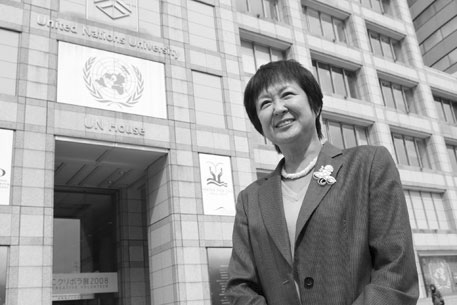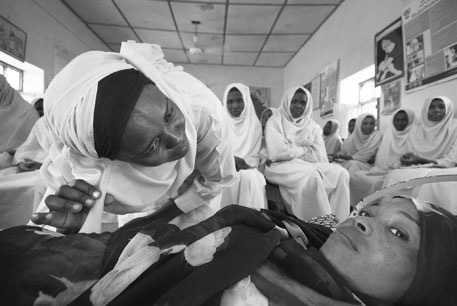Japan's Official Development Assistance White Paper 2010
Column 1 Effective Aid Through Partnerships
— Interview with Ms. Kiyoko Ikegami, Director of United Nations Population Fund (UNFPA) Tokyo Office —
Looking back on your work with the United Nations Population Fund (UNFPA), what was the most memorable experience for you?
I will never forget the traditional birth attendant I met in a village of Tanzania. She had two jars — one with a few black stones and the other with many white stones — and when a baby was delivered safely, she put a white stone in one jar, while when a baby died during delivery, she put a black stone in the other jar. I learned this was her own way to keep statistics of the outcomes for deliveries performed by her.
In developing countries, home delivery is common particularly in rural areas, and birth attendants need training to enhance their knowledge about the national health system, especially the referral systems as well as about sanitation. Actually, when I visited this village, the birth attendant was using a stone to cut the umbilical cord after deliveries. UNFPA’s partner NGOs advised the birth attendants to use instruments that can be sterilized such as a razor blade or scissors instead of a stone, and distributed to them the Clean Birth Kit in collaboration with a Japanese NGO and a Tanzanian NGO. The kit that costs around US$1 contains the minimum equipment required for a safe delivery, such as a plastic sheet and soap. This is an example of UNFPA’s partnership with NGOs in providing guidance on hygiene to birth attendants in order to improve the sanitary conditions of home deliveries.
Today, nearly half of the world’s population — estimated at 6.9 billion people — is under the age of 25. Therefore, it is important that these young people receive appropriate and correct information related to their own reproductive health. Moreover, it is crucial to ensure their universal access to knowledge and services on maternal and child health and family planning in order to promote birth spacing and safe motherhood.
At the G8 Summit held in 2010, the G8 leaders recognized that, as one of the development issues, the G8 should strengthen maternal and child health initiatives in developing countries. Could you tell me what you think of such outcome of the G8 Summit?
It is wonderful that the Government of Japan advocated for maternal and child health assistance in developing countries at the G8 Summit. In fact, some of the eight Millennium Development Goals (MDGs) are lagging behind, especially the fifth Goal, which is to improve maternal health. While the chances to save the lives of children through immunization, etc. are getting higher, there has been slow progress in reducing the number of mothers who die during delivery. Among the various causes of maternal mortality, the most common one is severe bleeding. However, it is possible to resolve this problem if drugs that stop the bleeding can be made available. Meanwhile, in some cases, mothers need caesarean sections as the last resort in order to save their own lives and their babies’, and this requires proper medical facilities with an adequate blood transfusion system. Such facilities may be available in large cities, but not in rural areas in developing countries. It is my hope that Japan will assist in providing emergency obstetric care (EmOC) to save the lives of mothers, together with provision of family planning services and midwives’ training.
The UNFPA Tokyo Office has carried out a ”Save Mothers Campaign” (*1), and 36,666 people supported the cause and became supporters during the campaign period. The list of names of all the supporters will be submitted to the Government of Japan, with the expectation that more ODA will be allocated to the activities aimed at saving the lives of mothers.
Regarding development cooperation implemented by Japanese ODA, international organizations and NGOs, what kind of assistance do you think is effective?
I believe it is ”partnership”. All stakeholders need to foster further partnerships with each other, i.e., governments and civil societies in developing and developed countries, as well as international organizations like UN agencies. In addition, more effective aid can be implemented through partnerships between NGOs in developing and developed countries, including Japan. Furthermore, involvement of the private sector is crucial. There are outstanding examples of assistance by Japanese private companies, including the one of Sumitomo Chemical’s Olyset ® Net (*2). This kind of public-private partnership helps Japanese people understand the important role of international assistance. Indeed, we need to keep seeking partnerships which involve all stakeholders who share responsibility as global citizens.
*1 June 2009 - July 2010
*2 An insecticidal mosquito net developed to fight malaria.

Ms. Kiyoko Ikegami, PhD, Director of UNFPA Tokyo Office (Photo: Yuichi Yoshitomi)

A student of a UNFPA-supported midwifery school providing antenatal care (Sudan)© Sven Torfinn/Panos/UNFPA

”Save Mothers Campaign” banner (Courtesy of UNFPA))
